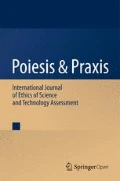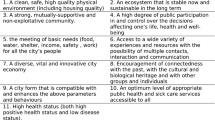Abstract
This study dealt with the interaction between two important trends in future Western societies, i.e. the greying of society and the technology-induced transformation of everyday life. It aimed at formulating a framework of policy recommendations with regard to the elderly and ICT in 2030. To meet this objective a three-phased methodology was developed, relying on methods of participatory technology assessment and technology foresighting. In the first phase of the project, a literature study, semi-structured expert discussions and focus groups with (future) elderly provided the necessary information for the development of scenarios about the future. In the second phase, these scenarios were transformed into a theatre play, which was performed for elderly audiences. Group discussions with senior participants led to the formulation of the “desired” future with regard to the elderly and ICT. During the last phase of the project—a backcasting exercise—experts and stakeholders from different fields formulated policy recommendations, necessary to achieve this future.
Zusammenfassung
Die vorliegende Studie behandelt die Wechselwirkung zwischen zwei wichtigen Entwicklungen für zukünftige westliche Gesellschaften: die Alterung der Gesellschaft und der technikbedingte Wandel des Alltagslebens. Das Ziel war die Formulierung von Rahmenempfehlungen für die Politik gegenüber Belangen der älteren Generation und für die weitere Gestaltung von Informations- und Kommunikationstechnologien bis zum Jahr 2030. Um diese Zielsetzung zu erfüllen, wurde eine Drei-Phasen-Methodik entwickelt, die sich auf Methoden der partizipatorischen Technikfolgeabschätzung und der Technikprognoseforschung stützt. In der ersten Phase des Projekts wurden durch Literaturstudien, semistrukturierte Expertendiskussionen und Fokusgruppenarbeit mit (zukünftig) älteren Mitbürgern die zur Entwicklung von Zukunftsszenarien benötigten Informationen gesammelt. In der zweiten Phase wurden diese Szenarien in Form von Theaterstücken umgesetzt, die vor älteren Zuschauerschaften präsentiert wurden. Gruppendiskussionen mit diesen Teilnehmern mündeten in die Formulierung erwünschter „Zukünfte” hinsichtlich der Belange Älterer und der Entwicklung zukünftiger Informations- und Kommunikationstechniken. Mittels einer Backcasting-Prozedur, die die letzte Phase des Projekts darstellte, formulierten dann Experten und Betroffene aus verschiedenen Bereichen Politikempfehlungen zur Ermöglichung dieser Zukunft.
Résumé
La présente étude porte sur l’interaction entre deux tendances majeures caractérisant les futures sociétés occidentales, c’est-à-dire le vieillissement de la population et la transformation de la vie quotidienne sous l’influence de la technologie. L’objectif était de formuler un cadre de recommandations politiques concernant la population âgée et les technologies de l’information pour l’an 2030. Pour y arriver, une méthodologie en trois phases a été développée. Elle s’appuie sur les méthodes de l’évaluation participative des conséquences de la technologie et sur les prévisions technologiques. Pendant la première phase du projet, une étude de la littérature spécialisée, des discussions d’experts semi-structurées et des groupes de travail focalisés composés de futures personnes âgées ont fourni les informations nécessaires pour mettre au point des scénarios d’avenir. Dans le courant de la deuxième phase, les scénarios ont été transformés en une pièce de théâtre, portée à la scène devant un public d’un certain âge. Des discussions de groupe avec des participants âgés ont ensuite permis de formuler le « futur souhaité » du point de vue des personnes âgées et des technologies de l’information. Au cours de la dernière phase du projet — un exercice d’extrapolation — des experts et des représentants de différents domaines ont formulé leurs recommandations sur les politiques à mener pour réaliser cet avenir.

Similar content being viewed by others
References
Bosma ES, Giezen-Biegstraaten LMGJ, de Ruiter P, Spaltman M, Stephan C (2000) Seniors and technology. KITTZ, Groningen
Coates V, Farooque M, Klavans R, Lapid K, Linstone HA, Pistorius C, Porter AL (2001) On the Future of Technological Forecasting. Technological Forecasting and Social Change 67:1–17
Cuhls K (2003) From forecasting to foresight processes—new participative foresight activities in Germany. J Forecast 22(2–3):93–111
Decker M, Ladikas M (eds) (2004) Bridges between science, society and policy. Technology assessment—methods and impacts. Springer, Berlin Heidelberg, NewYork, pp 250
EMCC (2003) Sector futures. Shaping the future of ICT. European Monitoring Centre on Change, Dublin. http://www.emcc.eurofound.eu.int/publications/2003/sf_ict_2.pdf
Davies S, Bolland B, Fisk K, Purvis M (2001) Strategic futures thinking: meta-analysis of published material on drivers and trends. European Monitoring Centre on Change, Farnborough. WWW: http://www.number-10.gov.uk/su/meta.pdf
Friedewald M, Da Costa O (2003) Science and technology roadmapping: ambient intelligence in everyday life (AmI@Life). JRC/IPTS – ESTO Study. European Science and Technology Observatory, Sevilla
Georghiou L (1996) The UK technology foresight programme. Futures 28(4):359–377
Harmsen B (2001) Evaluatie wetenschapstheater Dier Rathenau Instituut, 20 pp
Joss S (2002) Toward the Public Sphere – Reflections on the Development of Participatory Technology Assessment. Bulletin of Science, Technology & Society 22:220–231
Lengrand L, Associés PREST and ANRT (2002) Innovation tomorrow. Innovation policy and the regulatory framework: making innovation an integral part of the broader structural agenda. European Commission, DG Enterprise, Innovation papers no. 28, EUR 17052, Brussels
Merdes M (2003) A longer working life for Australian women of the baby boom generation? Women’s voices and the social policy implications of an ageing female workforce. School of Public Health, La Trobe University. http://member.melbpc.org.au/~monika/research.html
Nentwich M, Bütschi D (2002) The Role of Participatory Technology Assessment in the Policy-Making Process. In: Simon Joss, Sergio Bellucci (eds) Participatory Technology Assessment – European Perspectives. CSD/TA Swiss, London, pp 233–256
Slocum N (2003) Participatory methods toolkit. A practitioner’s manual. ViWTA & KBF, Brussels
Smits R, Kuhlmann S (2004) The rise of systemic instruments in innovation policy. In: The international journal of foresight and Innovation policy, vol. 1, no 1
Vig J, Paschen H (eds) (2000) Parliaments and technology. The development of technology assessment in Europe. State University of New York Press, New York
Author information
Authors and Affiliations
Corresponding author
Rights and permissions
About this article
Cite this article
Eggermont, S., Vandebosch, H. & Steyaert, S. Towards the desired future of the elderly and ICT: policy recommendations based on a dialogue with senior citizens. Poiesis Prax 4, 199–217 (2006). https://doi.org/10.1007/s10202-005-0017-9
Published:
Issue Date:
DOI: https://doi.org/10.1007/s10202-005-0017-9




